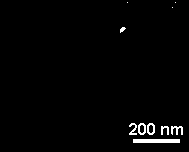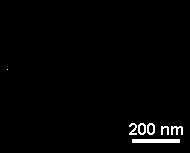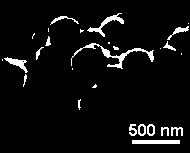Method for preparing hydrophobic drug-carrying core-shell structure micro/nanoparticles through electrostatic spraying
A hydrophobic drug, core-shell structure technology, applied in the field of pharmacy, can solve the limitations of the wide application of drug-loaded micro/nanoparticles, the poor stability of drug-loaded micro/nanoparticles, and the particle size distribution of drug-loaded micro/nanoparticles. It can achieve the effect of prolonging the action time of the drug, high affinity, and reducing the early burst release.
- Summary
- Abstract
- Description
- Claims
- Application Information
AI Technical Summary
Problems solved by technology
Method used
Image
Examples
Embodiment 1
[0021] A. Dissolve neogambogic acid, the active ingredient of anti-tumor plant medicine, and polylactic acid, a fat-soluble polymer material, in chloroform to form a homogeneous solution. The ratio of neogambogic acid to polylactic acid is 1:250, and the solution viscosity is 100 m·Ps;
[0022] B, dissolving the water-soluble polymer material chitosan in water to form a homogeneous aqueous phase solution, the solution viscosity is 100 m·Ps;
[0023] C. Slowly drop the solution of step A into the solution of step B. The ratio of the solution of step A to the solution of step B is 1:25. After forming an oil-in-water emulsion, spray it with a high-voltage electrostatic spraying method. The diameter of the nozzle is 0.4 mm. The speed is 0.02 ml / min, the voltage is 20 kV, and the collection distance is 15 cm. After collection and drying, the hydrophobic drug-loaded core-shell structure micro / nanoparticles are neogambogic acid-polylactic acid / chitosan.
Embodiment 2
[0025] This embodiment is the same as Embodiment 1, except that the hydrophobic drug in step A is the antipsychotic drug haloperidol, and the fat-soluble polymer material is polypropylene resin, and haloperidol and polypropylene The resin ratio is 1:100, the solution viscosity is 200 m·Ps; the water-soluble polymer material in step B is sodium carboxymethyl cellulose, and the solution viscosity is 200 m·Ps; The ratio of the solution is 1:50. After forming an oil-in-water emulsion, it is sprayed by a high-voltage electrostatic spraying method. The diameter of the nozzle is 0.5 mm, the spray speed is 0.05 ml / min, the voltage is 18 kV, and the collection distance is 17 cm. Finally, the hydrophobic drug-loaded core-shell structure micro / nano particles are haloperidol-polypropylene resin / carboxymethyl cellulose sodium.
Embodiment 3
[0027]This example is the same as Example 1, except that the hydrophobic drug in step A is the lipid-regulating drug lovastatin, the fat-soluble polymer material is polyisobutene, and the ratio of lovastatin to polyisobutene is 1:500 , the solution viscosity is 1500 m·Ps; the water-soluble polymer material in step B is gelatin, and the solution viscosity is 1500 m·Ps; the ratio of step A solution to step B solution is 1:100, after forming an oil-in-water emulsion The injection was carried out by high-voltage electrostatic spraying method, the diameter of the nozzle was 0.7 mm, the injection speed was 0.10 ml / min, the voltage was 15 kV, and the collection distance was 20 cm. Vastatin - polyisobutylene / gelatin.
PUM
 Login to View More
Login to View More Abstract
Description
Claims
Application Information
 Login to View More
Login to View More - R&D
- Intellectual Property
- Life Sciences
- Materials
- Tech Scout
- Unparalleled Data Quality
- Higher Quality Content
- 60% Fewer Hallucinations
Browse by: Latest US Patents, China's latest patents, Technical Efficacy Thesaurus, Application Domain, Technology Topic, Popular Technical Reports.
© 2025 PatSnap. All rights reserved.Legal|Privacy policy|Modern Slavery Act Transparency Statement|Sitemap|About US| Contact US: help@patsnap.com



